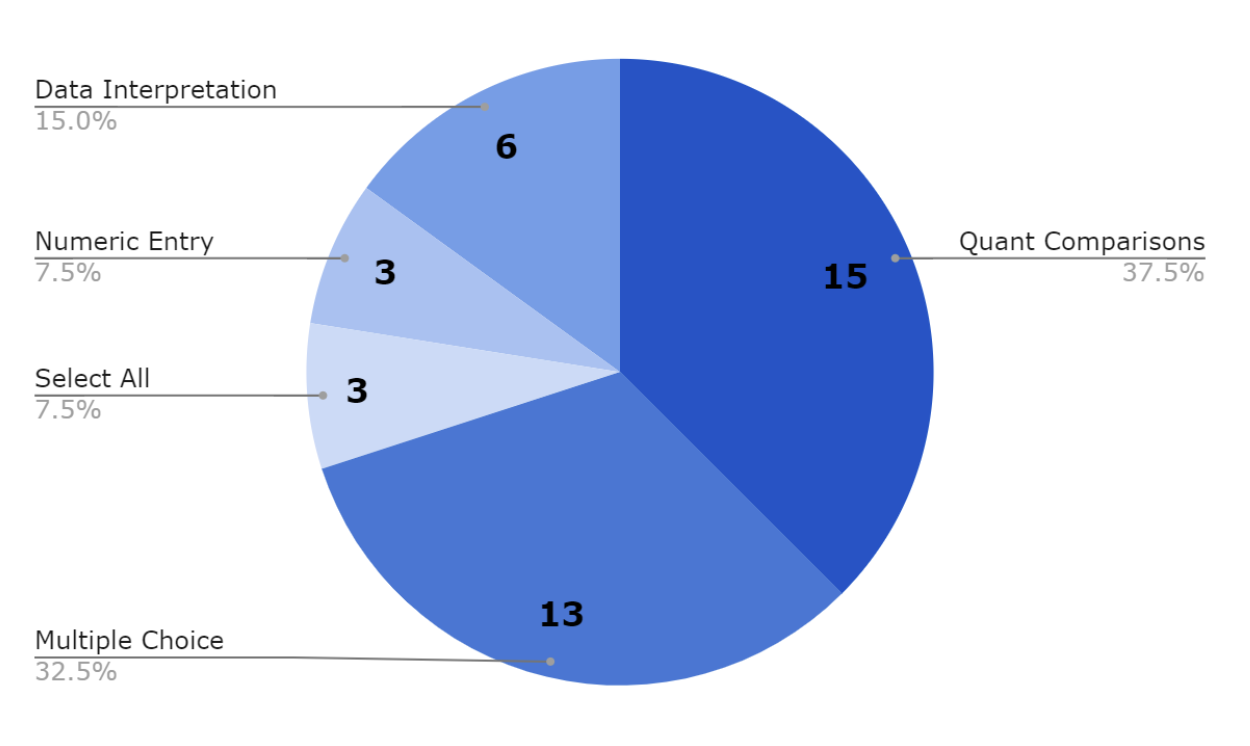Unlike GMAT quant, each GRE quantitative reasoning section is non-adaptive and can be navigated – you can visit and revisit any of the twenty questions for the duration of the thirty-five minute time limit. Each GRE quantitative section is also predictable in terms of the locations of different question types. This opens the door for a high level of strategizing. When the section isn’t adapting to you, you can adapt to the section.
Question Types on The GRE Quantitative Reasoning
First, let’s get familiar with the question types. There are five types of questions on the GRE quantitative sections:
Quantitative Comparisons (QC): The test-taker must identify the greater of two expressions, labeled “Quantity A” and “Quantity B.” Each QC question has the same answer choice set:
- Quantity A is greater
- Quantity B is greater
- The quantities are equal
- The relationship cannot be determined
Answer choice D means that either quantity may be greater depending on the scenario, or the value supplied to a variable. In some cases, quantity A is greater, and in other cases, Quantity B is greater.
Multiple Choice (MC): These are standard, five-answer-choice problems.
Select All (SA): A twist on multiple choice questions where there may be more than five answer choices in the set, with one or more (and potentially even all) choices being correct. These have square boxes instead of round bubbles and are always preceded by the instruction to “select all that apply.”
Numeric Entry (NE): Non-multiple choice questions that require the calculation of a precise value, to be typed into a text entry box. Sometimes these have specific instructions to “enter your answer as a fraction” or to “round your answer to the nearest tenth.”
Data Interpretation (DI): The four question types mentioned so far differ in terms of answer choice format, but Data Interpretation questions do not represent a fifth such format. They may be multiple choice, select all, or numeric entry (never quantitative comparisons) but are distinct from these question types because of the difference in the tasks required to answer them. On a GRE quant section, there are always three consecutive DI questions that ask about the same set of text, graphs, and tables. Hence the name “Data Interpretation.”
Now that we’ve overviewed the five question types, let’s take a look at how they work together to form a complete GRE quantitative reasoning section:
| Question Number | Question Type |
| 1 – 7 or 1 – 8 | QC |
| 8 – 13 or 9 – 13 | MC, SA, and NE (jumbled) |
| 14 – 16 | DI |
| 17 – 20 | MC, SA, and NE (jumbled) |
There are 7 or 8 QC questions per section and a total of 15 QC questions between the two scored quantitative sections on the GRE. If one quantitative section has 7 of them, the other section will have 8, and vice versa. If you’re a by-the-book kind of test-taker, you can do these questions first. But if you tend to be more confident on the traditional multiple choice questions, you can start with those and come back to the QC questions later.
For what it’s worth, the DI questions are always numbers 14 through 16. If you want to start here, just use the “review” screen to navigate right to question 14.
The standard MC questions are much more heavily represented than the SA and NE questions. There is a kind of balance between QC and MC questions, so that each quantitative section contains a total of 14 questions between these two types. If a section has 8 QC questions, it will have 6 MC questions (for a total of 14). And if a section has 7 QC questions, it will have 7 MC questions (again, for a total of 14). If you’ve been keeping track, this leaves only 3 questions per section for SA and NE.
The SA and NE questions also maintain a balance. You won’t get 3 SA questions on one section and then 3 NE questions on the other section; you’ll get one section with 2 SA and 1 NE and another section with 1 SA and 2 NE.
Question Types by Section:
- QC: 7 or 8
- MC: 6 or 7
- DI: 3
- SA: 1 or 2
- NE: 1 or 2
- Total: 20
Question Types for both Sections:
- QC: 15
- MC: 13
- DI: 6
- SA: 3
- NE: 3
- Total: 40

Knowing all this helps you know what to expect on test day. Familiarity tends to increase comfort. And most importantly, you can use your practice tests to try out different approaches to the quantitative sections. Are open-ended QC questions giving you a headache? Flag them and go take a break with the more concrete DI questions. Struggling to finish the section on time? Prioritize the question types you’re most comfortable with, and use the remaining time on the harder ones. You can develop a personalized approach to the GRE quantitative sections that plays to your strengths.
Now that we know how the GRE quantitative sections are put together, we’ll turn to overviewing the actual math content of the questions in our next article.
If you need help preparing for GRE, book a 30-minute free consultation with our senior instructors to understand how we can help you get into your dream school.
